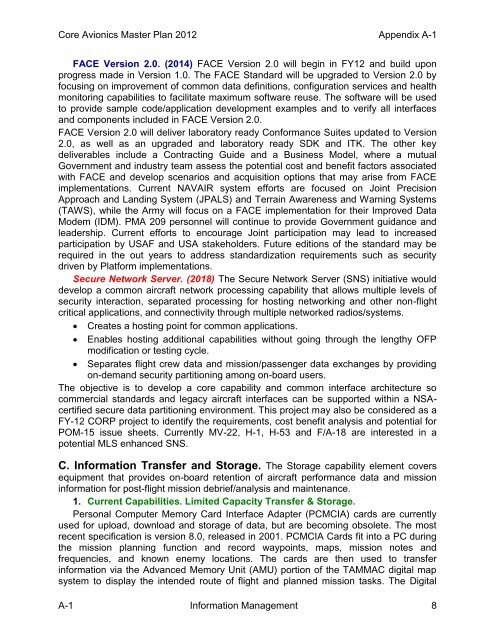PMA209 2012 Core Avionics Master Plan - NAVAIR - U.S. Navy
PMA209 2012 Core Avionics Master Plan - NAVAIR - U.S. Navy
PMA209 2012 Core Avionics Master Plan - NAVAIR - U.S. Navy
Create successful ePaper yourself
Turn your PDF publications into a flip-book with our unique Google optimized e-Paper software.
<strong>Core</strong> <strong>Avionics</strong> <strong>Master</strong> <strong>Plan</strong> <strong>2012</strong> Appendix A-1FACE Version 2.0. (2014) FACE Version 2.0 will begin in FY12 and build uponprogress made in Version 1.0. The FACE Standard will be upgraded to Version 2.0 byfocusing on improvement of common data definitions, configuration services and healthmonitoring capabilities to facilitate maximum software reuse. The software will be usedto provide sample code/application development examples and to verify all interfacesand components included in FACE Version 2.0.FACE Version 2.0 will deliver laboratory ready Conformance Suites updated to Version2.0, as well as an upgraded and laboratory ready SDK and ITK. The other keydeliverables include a Contracting Guide and a Business Model, where a mutualGovernment and industry team assess the potential cost and benefit factors associatedwith FACE and develop scenarios and acquisition options that may arise from FACEimplementations. Current <strong>NAVAIR</strong> system efforts are focused on Joint PrecisionApproach and Landing System (JPALS) and Terrain Awareness and Warning Systems(TAWS), while the Army will focus on a FACE implementation for their Improved DataModem (IDM). PMA 209 personnel will continue to provide Government guidance andleadership. Current efforts to encourage Joint participation may lead to increasedparticipation by USAF and USA stakeholders. Future editions of the standard may berequired in the out years to address standardization requirements such as securitydriven by Platform implementations.Secure Network Server. (2018) The Secure Network Server (SNS) initiative woulddevelop a common aircraft network processing capability that allows multiple levels ofsecurity interaction, separated processing for hosting networking and other non-flightcritical applications, and connectivity through multiple networked radios/systems. Creates a hosting point for common applications. Enables hosting additional capabilities without going through the lengthy OFPmodification or testing cycle. Separates flight crew data and mission/passenger data exchanges by providingon-demand security partitioning among on-board users.The objective is to develop a core capability and common interface architecture socommercial standards and legacy aircraft interfaces can be supported within a NSAcertifiedsecure data partitioning environment. This project may also be considered as aFY-12 CORP project to identify the requirements, cost benefit analysis and potential forPOM-15 issue sheets. Currently MV-22, H-1, H-53 and F/A-18 are interested in apotential MLS enhanced SNS.C. Information Transfer and Storage. The Storage capability element coversequipment that provides on-board retention of aircraft performance data and missioninformation for post-flight mission debrief/analysis and maintenance.1. Current Capabilities. Limited Capacity Transfer & Storage.Personal Computer Memory Card Interface Adapter (PCMCIA) cards are currentlyused for upload, download and storage of data, but are becoming obsolete. The mostrecent specification is version 8.0, released in 2001. PCMCIA Cards fit into a PC duringthe mission planning function and record waypoints, maps, mission notes andfrequencies, and known enemy locations. The cards are then used to transferinformation via the Advanced Memory Unit (AMU) portion of the TAMMAC digital mapsystem to display the intended route of flight and planned mission tasks. The DigitalA-1 Information Management 8

















